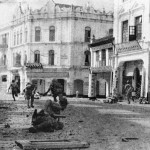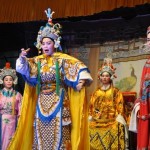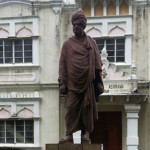ARRIVAL OF THE EURASIANS
The Eurasian community in Penang started with the arrival of the British in 1786. Responding to the invitation of Captain Francis Light, the first group of Eurasians, who had settled in Kedah, landed in Penang on 15 August 1786, the eve of the Feast of the Assumption. This community set up an enclave in China Street and Bishop Street. They built a wooden church and called it “Assumption Church”. The two most significant traits of the Eurasians at that time were a Roman Catholic religion and a command of the English language, unique at the time among the various races.
In 1810, a group of Portuguese Eurasians relocated from Phuket to Penang, They settled in Pulau Tikus. The focal point of this Catholic community was the Church of the Immaculate Conception, which they built. A school, commonly known as “Noah’s Ark”, was eventually built to serve the community, which lived in areas surrounding the church. This whole area came to be known as “Kampong Serani” (or “Eurasian Village”).
EARLY ACTIVITIES
Being decidedly literate, the Eurasians very quickly proved themselves to be eminently suitable in all branches of Government and Municipal service. Because of their fluency in the English language, they also found employment very easily in commerce and trading. In the early years, Penang was said to be practically run by a handful of Eurasians! These activities continued throughout the 1800’s and early 1900’s, by which time Eurasians also began to demonstrate a special aptitude for technical and industrial pursuits.
The Eurasians were largely urban dwellers. They lived close to their offices and were closely involved in the construction and development of two important urban schools, namely Saint Xavier’s Institution in Farquhar Street for boys and Convent of the Holy Infant Jesus in Light Street for girls. These schools were founded in 1852. In 1860, the Church of the Assumption was rebuilt on its present site in Farquhar Street.
One other important aspect of the early Eurasian community in Penang was the significant role played by women in economic activity. Eurasian women formed the mainstay of the teaching staff in the girls’ schools and the nursing staff of hospitals. They also entered public service and mercantile offices in large numbers.
CONTRIBUTIONS TO ECONOMIC AND SOCIAL DEVELOPMENT
When looking at the contribution of Eurasians to economic and social development of Penang, one must first put into perspective the total number of Eurasians who lived on the island, as against the total population of the island. From a few hundred, the Eurasian population grew to about 2000, but this was (and still is) much less than one percent of the population of Penang. Against this background, it can be clearly seen that Eurasian contributions have been far out of proportion to their numerical strength.
The most striking contribution Eurasians have made to the development of Penang has been in the field of Education. Eurasian men and women have taught in large numbers in two of the oldest schools in Malaya, namely Saint Xavier’s Institution and Convent of the Holy Infant Jesus. In Saint Xavier’s Institution for example, teachers like Robbie Robless, Arthur de Cruz, Joe Cornelius, Jimmy Boyle, and Colin Rozells were pillars of the school for a good part of the 1900’s. They not only had excellent teaching ability, but also contributed significantly to the student body and community. Robbie was also a choir master of the Church of the Assumption, a choir so well-known for its singing at that time that Radio Malaya would come and make recordings every now and then for airing all over the country. He was also the leader of the school’s marching band, which included drums and bagpipes. Arthur was the organist the Church of the Assumption. Joe was a violinist in the school orchestra. Jimmy was a well known composer/musician whose songs would drift over the school’s corridors every now and then when he had free periods between teaching assignments to play the piano. Colin, as a national sprinting champion, played a dominant role in raising the athletic level of the school. He was also responsible for the Red Cross Movement in the school. I was very fortunate to have, and to know, all these Eurasians as my teacher/coach during my school career.
Eurasian women were equally active and successful in the Convent of the Holy Infant Jesus. Well known personalities included Ms. Ruth Coombs, Minette Foley, Olive Andrews, Marina Beltram, Charlotte Reutens, and Joan Nonis. My mother, Joan, almost single-handedly taught the “Commercial Class” which provided girls with skills leading to certification in Shorthand, Typewriting, and Commercial Correspondence. Hundreds of girls who trained under her went on to fill the offices all over Penang Island.
Eurasians also taught in Government schools in Penang. For example, an important primary school was the Wellesley Primary School, which fed students to a leading secondary school, the Penang Free School. Eurasian teachers in Wellesley Primary School included Tony Foley, Barbara Robless, Glenn Johnson and Alexander Nonis. My father, Alexander, went on to become the Headmaster of Ayer Itam English School and later Glugor English School. When he retired in 1969, he had taught for almost forty years! Many of the leading citizens in Penang had him as their primary school teacher.
Consistent with their special aptitude for technical and industrial pursuits, Eurasians have excelled in various engineering and technical fields. One excellent example has been in Marine Engineering Up to the time the present bridge linking Penang Island to Mainland Malaya was built, the only physical link was by a ferry service owned and operated by the Penang Port Commission. The ferries, as well as all the other floating craft owned by the Commission such as barges, launches and tugboats (which were largely built in Sungei Nyor dockyard) were repaired and maintained at another dockyard at Bagan Dalam. The trend among Eurasians was to serve apprenticeship at Sungei Nyor dockyard (apprentices included Colin de Cruz, John Robless, Charles Reutens, Stanley de Souza and Gerald Green). When I had an assignment to review the productivity of Bagan Dalam dockyard in 1968, I was surprised to find that the Dockyard Manager/Chief Engineer and the other four Engineers who saw to the various operations of the dockyard were all Eurasians, namely Jimmy Anchant, Ivan Capel, Roland de Bruin, Russel du Pratt and Jimmy Karl. Not only did these Eurasians ensure that the ferries were operationally safe at all times, but also at least one of them was on stand-by duties twenty four hours a day (as this was a legal requirement for the ferries to run twenty four hours). Imagine how the public would have reacted if the ferry service had to stop because the engineers only worked the usual eight hours a day?
Water Supply in Penang island has been another sector where Eurasians have made significant contributions. From filteration to treatment, reservoir and dam storage to water supply control and inspection, Eurasians have been involved in providing technical services. Names that come readily to mind include Frank Lopez, Vincent Jeremiah, James Jeremiah, Conrad Scully and Elvin Capel. In a similar way, the power sector in Penang has seen Eurasians contribute in generation, transmission and distribution activities.
On the social side, Eurasians have been noted for their ability to organize and excel in various social and sporting activities. In 1919, the Penang Eurasian Association was formed to promote the social, welfare, moral and intellectual advancement of all Eurasians in Penang as well as maintain cordial relations within the community and the other communities in Malaya towards the development of the country. The Association has met its objectives and continues to be operationally active. Many of its members have been outstanding Musicians/Singers (as the next presentation this colloquium by James Rozells and Kathleen Rodrigues will prove.)
In Sports, two all-round Eurasian athletes stand out for their outstanding achievements. Chris Danker represented Penang in soccer and hockey for many years and he was a good long-distance runner. Ronnie Perera was an undefeated amateur feather and lightweight boxing champion of Malaya. He was also a cyclist, swimmer and shooter and an athlete, hockey, rugby and cricket player. Between 1939 and 1970, he bagged a total of 1911 medals and trophies, and was nicknamed “human dynamo” because of his stamina and strength. Other Eurasians also excelled in various sports, including Maurice Pestana, the Penang and Malayan rugby captain, Poppy Williams in cricket, Colin Rozells in athletics and Lawrence Robless and Eustace Nonis who were champions in tennis and Penang state players.
THE SITUATION TODAY
Eurasians continue to contribute actively to economic and social activity not only in Penang, but also throughout Malaysia and internationally. In education for example, Eurasian men and women are still teachers in large numbers, but they have broadened their horizons as educators. Gerald Green is a professional, speaker and speech trainer with his own business. Tony Sibert is the Dean of Continuing Education and Training for the Olympia/Raffles Education Group of Colleges. Cosmos Robless has done Penang proud by being a Senior Officer in the World Bank in Washington D.C. Eustace Nonis was a Senior Economist with the Asian Development Bank in Manila and he became a Director of the Bank, responsible for its largest Department. The next generation of Penang Eurasians is showing encouraging signs that it will carry on with what began in 1786, and that it will be even more successful than the generations before.


